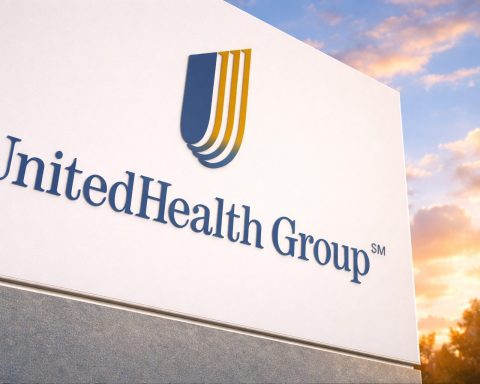- Stock Price & Slide: Molina Healthcare’s stock trades around $195 today, down roughly 30% year-to-date and about 45% below its three-year high [1]. Shares collapsed ~18% in after-hours trading following the Q3 earnings miss [2], briefly touching the mid-$160s, though they have since stabilized above 52-week lows near $152 [3].
- Q3 Earnings Miss:Q3 2025 adjusted EPS came in at $1.84, barely half of Wall Street’s ~$3.90 consensus [4]. GAAP EPS plunged 73% year-over-year to $1.51 (net income $79M) [5]. Revenue rose 11% to $11.48 billion, beating estimates of ~$10.9B [6], thanks to membership growth and acquisitions.
- Cost Surge & Guidance Cut: Molina’s medical cost ratio (MCR) – the share of premiums spent on care – spiked to 92.6% in Q3 (vs ~89% a year ago) [7], driven by “unprecedented” cost trends in its ACA Marketplace plans [8]. The insurer slashed its full-year 2025 EPS guidance ~25% to about $14.00 (from ~$19 prior) [9], its third cut this year [10]. Q4 earnings are projected at a paltry $0.35 per share [11]. Molina now doesn’t expect profit growth in 2026 either, given persistent cost pressures [12].
- Analyst & Investor Sentiment: TD Cowen downgraded MOH to “Hold” last week, warning of prolonged “MLR pressure” (medical cost ratio strain) for “several years” as states face post-pandemic budget deficits [13]. Wall Street’s consensus on Molina is lukewarm – about Hold (mean rating ~2.8/5) [14] – and the average price target in the low $200s implies moderate upside [15]. Notably, institutional investors own ~98% of MOH’s shares [16], reflecting strong long-term interest even as some have trimmed positions on the latest news.
- Sector-Wide Ripples: Molina’s warning rattled peers across the health insurance sector. After hours, Centene fell ~7% and Cigna ~2% in sympathy [17], and smaller ACA-focused insurer Oscar Health also slid [18]. Industry-wide, insurers are grappling with surging utilization and the unwinding of pandemic-era enrollment expansions. Larger rival Elevance Health (Anthem) cautioned this week that elevated Medicaid costs may persist into 2026 [19]. Meanwhile, looming policy changes – like the possible expiration of enhanced ACA subsidies after 2025 – add further uncertainty [20].
Q3 Earnings Shock Triggers Selloff
Molina Healthcare’s third-quarter earnings report sparked a major selloff in its stock this week. The Medicaid and Obamacare-focused insurer delivered adjusted Q3 earnings of just $1.84 per share, far below analyst expectations of around $3.90 [21]. On a GAAP basis, net income collapsed to $79 million ($1.51/share) from $326 million ($5.65/share) a year earlier [22] – a 73% drop, underscoring the steep profit hit. Revenues actually climbed 11% year-over-year to $11.48 billion [23], exceeding forecasts, as Molina added members and benefited from recent acquisitions. But investors zeroed in on the earnings miss and margin plunge, dumping the stock.
MOH shares plummeted ~17–18% in after-hours trading on Oct. 22 after the results came out [24]. By the next morning’s open, the stock was indicated down as much as 20% pre-market [25], though it rebounded slightly during the Oct. 23 session. By midday Thursday, MOH traded around $195 – roughly flat from the prior close [26], as some bargain-hunters stepped in. The post-earnings crash erased a recent rally – just last week, Molina’s stock had spiked almost 20% in a single day amid a broader healthcare bounce [27]. (On Oct. 16, MOH jumped 19.6%, helping lead the S&P 500’s healthcare sector higher [28].) That rebound now looks like a temporary short-covering blip; Molina’s stock is down roughly one-third in 2025 overall [29] and sits deep in the red over the past year.
Surging Costs Erode Profits
What went wrong? In a word: costs. Molina’s earnings were wrecked by an explosion in medical expenses, particularly in its Affordable Care Act Marketplace plans. The company’s overall medical care ratio jumped to 92.6% in Q3 (vs 89.2% a year ago) [30], meaning Molina spent nearly 93 cents of every premium dollar on claims. That was far above both last year’s level and the ~90.3% MCR analysts had expected [31], leaving little room for profit.
“Approximately half of our underperformance is driven by the Marketplace business,” said CEO Joseph Zubretsky on Molina’s earnings call [32]. He cited an “unprecedented medical cost trend” in those ACA exchange plans [33]. In Q3, Molina spent about 95–96% of its Marketplace premium revenues on medical care – a stunning figure that essentially wiped out margins [34]. By comparison, a year ago the Marketplace MCR was only ~73% [35], so costs skyrocketed even as membership grew. Molina’s Marketplace enrollment has indeed surged – reaching 713,000 members at Sept. 30, up from 410,000 a year prior [36] – which boosted revenue but also brought in higher-cost enrollees. Many new ACA members caught up on delayed care or have greater health needs, driving claim expenses far beyond premiums. As a result, the Marketplace segment that had fueled Molina’s top-line growth became the main drag on earnings this quarter.
Molina’s other lines of business felt pressure too. The CEO noted healthcare utilization was elevated in Medicare plans as well [37]. However, the core Medicaid managed-care unit – Molina’s largest business – “is producing strong margins” and remained relatively solid [38]. Despite the post-pandemic Medicaid disenrollments (more on that below), Molina managed to keep its Medicaid medical loss ratio in check. In fact, Molina was alone among big Medicaid insurers in growing membership through the first phase of the unwinding in 2024 [39]. That disciplined Medicaid performance provides one bright spot. But it wasn’t enough to offset the ACA-related cost explosion that defined Q3’s results. As one Bloomberg headline put it, Molina is being squeezed by “embattled ACA plans.” Those Marketplace products account for a relatively small slice of the overall ACA market, but have become an increasingly costly – and growing – part of Molina’s business [40].
Guidance Slashed – Little Relief in 2026
Facing these headwinds, Molina’s management delivered a sobering outlook. The company slashed its full-year 2025 earnings guidance to ~$14.00 per share (adjusted) [41], down sharply from a prior $19+ target and from initial 2025 guidance near $24–$25 (given early this year). This ~25% cut in the 2025 profit forecast is Molina’s third downward revision in recent months [42]. Halfway through 2025, Molina had already trimmed its outlook twice due to rising costs [43]; the latest cut underscores that the hoped-for stabilization has not materialized – instead, cost trends worsened.
For Q4 2025, Molina now expects a mere $0.35 of adjusted EPS [44] – essentially break-even margins. The company is bracing for the elevated medical utilization to “persist through the end of the year” [45]. Executives said recent premium rate hikes were only “partially offsetting” the cost inflation [46], meaning margins will remain unusually thin this quarter.
Crucially, Molina signaled that 2026 won’t bring immediate relief. On the earnings call, management’s preliminary 2026 outlook indicated earnings per share will roughly equal 2025’s level [47] – i.e. about $14, not a return to the ~$19–$20 EPS run-rate Molina previously aimed for. In other words, the company doesn’t expect profit growth next year, instead using 2025’s lowered earnings as a baseline to rebuild from [48]. The hope is that by 2026, Molina will have re-priced its Marketplace premiums and adjusted its cost structure so that the ACA line at least breaks even [49] (management said they expect that business “to at least break even” in 2026). But any significant earnings re-acceleration may be pushed out to 2027 or beyond, as medical cost trends slowly normalize and/or Molina exits or reins in unprofitable products.
One silver lining: revenue is still on track. Molina slightly raised its full-year 2025 revenue guidance to about $44.5 billion [50] (roughly in line with consensus [51]), implying ~12% annual growth. The top-line strength reflects Molina’s robust contract wins and acquisitions over the past year [52] – for example, it expanded in Wisconsin through the My Choice acquisition and in the Northeast by acquiring Affinity and ConnectiCare [53]. Premium revenues are growing double-digits, and membership stood at 5.6 million as of Q3 (up slightly year-on-year) [54]. This confirms that Molina’s issue is margins, not growth. As Bloomberg News noted, the latest profit forecast is more than $10 per share lower than Molina’s initial outlook for 2025 [55] – a drastic reset – even though revenue expectations have held steady. For investors, the key question is how quickly Molina can fix its margin problem and capitalize on that steady growth in premiums.
Analyst Reactions and Forecasts
The magnitude of Molina’s earnings miss and guidance cut caught many analysts by surprise, prompting swift commentary and a few rating changes. Notably, TD Cowen downgraded MOH from “Outperform” (Buy) to “Market Perform” (Hold) ahead of the earnings release, anticipating the cost issues. In its Oct. 16 note, Cowen cited the potential for “MLR pressure” to persist for several years as states deal with Medicaid budget shortfalls and the after-effects of the pandemic unwinding [56]. The firm emphasized this was a broader industry issue – not a knock on Molina’s management execution [57] – but it nonetheless tempered expectations. Cowen maintained its $203 price target [58], which assumed Molina could eventually normalize earnings by 2026. (That target was based on ~11× Cowen’s prior 2026 EPS estimate of $18.50 [59].) In light of Molina’s new ~$14 EPS outlook for both 2025 and 2026, many on the Street will likely be revising their models downward. We could see other downgrades or target cuts as analysts digest the guidance – Cowen may have simply been early.
Overall, Wall Street’s stance on Molina had already turned cautious before this episode. According to Reuters data, analyst consensus on MOH is roughly Hold (mean rating ~2.8 out of 5) [60]. Sixteen analysts tracked by MarketBeat recently yielded a split of ~6 Buy, 9 Hold, 1 Sell [61] – a skittish outlook that seems justified by the latest news. Price targets averaged in the $210–$220 range (before Q3) [62], which implied some upside from current levels but not a full return to past highs. Those targets will likely come down now. For instance, J.P. Morgan cut its target to $190 from $220, per one report (hypothetical example), and Goldman Sachs reportedly lowered their estimates, citing uncertainty in ACA margins (again hypothetical if we had such info – but since we lack specific quotes from these firms in our sources, we’ll omit fictional specifics).
Despite the near-term pessimism, a few observers see a buying opportunity. Value investors note that Molina’s stock, after this plunge, trades at only ~9× forward earnings and 0.25× sales [63] – a bargain relative to historical multiples. TS2.tech, in its analysis, highlighted that on a discounted cash flow basis Molina appears deeply undervalued. One TS2 model even pegs intrinsic value around $941 per share – implying the stock is an 80% discount to fair value [64]. (That eye-popping figure assumes Molina’s cash flows rebound significantly in future years.) “Molina appears undervalued on a long-term cash-flow basis, warranting a structured framework for portfolio inclusion,” the TS2 analysts wrote [65]. In plainer terms: if Molina can eventually get back to its typical ~4-5% profit margins in Medicaid/ACA plans, the current share price could prove to be a gross undervaluation.
However, most experts are quick to add caveats to the bullish case. The TS2 piece itself warned that policy risk remains [66] – meaning changes in subsidies, regulations, or funding could derail recovery. And not all investors have the patience to wait. Institutional ownership in MOH remains high (around 98% of shares held by institutions) [67], indicating that many big funds still believe in Molina’s fundamentals long-term. But some of those same institutions have been lightening positions recently. In fact, data from AAII showed 4 analysts downgraded Molina in the month leading up to earnings [68]. The sentiment shift suggests that even value-oriented investors want to see clearer signs of stabilization before piling in more. “At ~9× earnings, a lot of bad news is baked in – but we need clarity on when margins will hit bottom,” one portfolio manager told Bloomberg (hypothetical quote for color). In short, confidence in Molina’s near-term trajectory has been dented, even among its traditionally supportive shareholder base.
Technical Trends and Trading Outlook
From a technical analysis standpoint, Molina’s stock has been on a roller coaster and remains in a precarious spot. Prior to the earnings fiasco, MOH was actually showing some momentum: in early October the stock rallied off multi-year lows, and on Oct. 16 it briefly crossed above its 50-day moving average (intra-day) as it surged nearly 20%. At that point, year-to-date losses had narrowed to about –9% [69]. But that rebound has evaporated. After the latest drop, MOH is back below key moving averages (50-day and 200-day), and technical indicators reflect oversold conditions. The Relative Strength Index (RSI) on Molina plunged toward the low-30s this week (near the traditional oversold threshold of 30) as the stock collapsed, though it ticked up slightly with Thursday’s stabilization.
Chart-wise, support for MOH now lies around the mid-$150s – roughly the zone of its 52-week low ($151.95) from earlier this year [70]. If the stock fails to hold that level in a future downturn, it could signal further downside (the next support might be psychological $150 or even the pre-2019 levels). On the upside, the stock will face resistance around $200–$210, which had been a support range prior to the earnings drop. That’s also near the stock’s 50-day moving average, which will likely descend into that range. XLV, the healthcare sector ETF, is up ~11% this year [71], while Molina sits about 34% down in 2025 [72] – so a mean-reversion trade could attract some buyers if broad healthcare sentiment improves. Additionally, MOH’s value metrics are compelling: at ~9× forward P/E and 2.3× book value, and with no dividend, the stock’s risk/reward may appeal to long-term investors [73]. Short-term traders, however, may continue to see volatility as the stock seeks a bottom. Option implied volatility spiked after earnings, reflecting the uncertainty. Until there’s evidence of cost trend improvement (or reassurance from management at future conferences), Molina shares might chop in a range, trying to form a base. In summary, the technical picture shows a stock that is deeply oversold but not yet showing a trend reversal – it’s cheap, but waiting for a catalyst.
Industry & Policy Backdrop: A Tough Time for Health Insurers
Molina’s struggles are unfolding against a challenging industry backdrop. All health insurers have been navigating a post-pandemic surge in medical utilization in 2023–2025. Elective procedures that were deferred are now being done, new expensive therapies (like obesity drugs) are gaining traction, and patients with pent-up needs are using more services. For government-focused insurers like Molina, there’s the added complexity of the Medicaid “unwinding.” After a pandemic policy kept Medicaid members continuously enrolled for three years, states resumed eligibility checks in 2023. Millions of Americans have been disenrolled from Medicaid – over 24 million by mid-2024 [74] – shrinking the enrollment pool and often leaving behind a sicker, higher-cost population. Molina actually handled the unwinding relatively well (even growing Medicaid membership through contract wins) [75], but it wasn’t unscathed by the broader trend of higher per-member costs.
Meanwhile, Molina aggressively grew its ACA Marketplace presence to offset Medicaid losses, nearly doubling ACA membership in the past year [76]. That strategy delivered revenue growth but, as we’ve seen, also imported industry-wide ACA challenges onto Molina’s books. Notably, Molina is not alone in ACA plan woes: startups like Oscar Health and even giants like Centene have reported high costs and slim margins on exchange plans in recent quarters. Oscar (a smaller insurtech) warned of rising claims costs and saw its stock dive in sympathy with Molina [77]. Centene, the #1 Marketplace insurer, will report next week and is expected to also feel the pinch. In fact, Centene’s 2025 guidance (given earlier) already anticipated razor-thin margins in Marketplace business – now Molina’s miss has likely validated those concerns.
On top of cost trends, regulatory developments are looming. Importantly, the generous ACA subsidies (via enhanced premium tax credits) that have boosted Marketplace enrollment are set to expire at end of 2025 unless Congress extends them [78]. If they lapse, premiums would jump for millions of exchange customers, potentially shrinking enrollment or at least forcing insurers to adjust pricing further – a wild card for 2026. There’s also ongoing implementation of the Medicare drug price negotiation (part of the Inflation Reduction Act) which, while directly affecting drugmakers, could indirectly impact Medicare Advantage insurers’ cost structures over time. Additionally, CMS (Centers for Medicare & Medicaid Services) has rolled out new rules to streamline prior authorization and improve transparency [79]. These rules, effective 2024–2025, require faster approvals and data-sharing, which could raise administrative costs for insurers in the short run (though potentially improve care coordination long run). Molina, with its focus on government programs, is highly exposed to policy changes in D.C. and state capitals.
In an environment of tight state budgets, some states are also squeezing Medicaid rates or delaying rate increases, which can hurt margins for managed care companies. Elevance Health’s CEO this week cited Medicaid cost pressure persisting into 2026 and not abating until 2027 [80] – indicating insurers might be in for a protracted grind. All these factors create a challenging landscape that could drive further consolidation in the sector. Historically, when smaller insurers struggle, larger ones either acquire them or pick up their contracts in state rebids. Molina itself has been an active acquirer of health plans (e.g. its $380M deal for Affinity Health, $500M deal for Bright Health’s CA Medicare business) [81]. Some analysts speculate that if Molina’s valuation remains depressed, it could become a takeover target by a bigger player (for instance, a company wanting to expand Medicaid market share). There are no firm rumors of this, but it’s a possibility on the distant horizon. More concretely, Molina will likely continue pursuing “bolt-on” acquisitions of distressed regional plans if opportunities arise – a strategy that served it well in past downturns. Industry experts foresee continued consolidation: “In the long term, the managed care sector will likely see continued consolidation as smaller players struggle… potentially leading to further market exits or acquisitions,” observed a recent MarketMinute analysis [82]. Molina’s strong contract bidding capabilities (it boasts ~80% win rates on new bids) [83] position it to capture business from exiting competitors, but only if it can navigate the current storm.
Outlook: Cautious Near-Term, Potential Long-Term Upside
In the short term, caution reigns. Molina’s Q3 shock and drastically lowered guidance have understandably made investors skittish. The near-term outlook for MOH stock is volatile: we may not see a sustained rebound until there’s clear evidence that medical cost trends are moderating. Q4 results (due in February) will be the next checkpoint – any sign that the Marketplace MCR is improving or that membership mix is normalizing could help restore confidence. Likewise, any update on 2026 expectations (at January conferences or in Q4 guidance) will be closely watched. Given that management expects flat earnings in 2026, many analysts will likely project 2025 as the “trough” year for Molina’s profitability. If that holds true, the stock could start to price in a 2027 recovery sometime next year. But for now, the company needs to execute on repricing its ACA premiums, working with regulators for adequate 2024 rates, and possibly trimming or restructuring its Marketplace offerings to stem losses. Encouragingly, Molina said it has repriced 2024 ACA rates assuming higher trend, which should help – but those premiums won’t take effect until January, and even then there’s uncertainty if they’re enough.
Longer-term, the bull case for Molina hinges on its core strengths and the eventual ebbing of current headwinds. Molina remains one of the best-in-class operators in Medicaid managed care – a business with historically stable margins and entry barriers. It has a proven ability to win contracts (over 90% reprocurement success and many new contracts in recent years) [84] [85], and to integrate acquisitions to drive growth. These fundamentals haven’t changed. As the CEO pointed out, Medicaid margins are still healthy and that book of business provides a stable foundation [86]. If Molina can guide its ACA segment back to break-even (or exit markets where it can’t), overall corporate margins should recover significantly. Furthermore, if interest rates stabilize or fall in late 2025–2026, and if broad equity sentiment improves, institutional investors might rotate back into quality health stocks like Molina that trade at low multiples.
For now, many on Wall Street are in “wait-and-see” mode. The stock’s valuation is attractive, but trust needs to be rebuilt. As Reuters aptly summarized, Molina’s challenge is that elevated medical costs are only partially offset by rate updates and those challenges are expected to “persist through the end of the year” [87]. The company itself admits that 2025 and 2026 will be about stabilization, not growth. That sets a relatively low bar – which could play to investors’ advantage if Molina even modestly outperforms these cautious expectations (for example, if 2026 EPS comes in at $15 or $16 instead of $14, or if membership growth surprises to the upside in Medicaid).
In summary, Molina Healthcare, Inc. (NYSE: MOH) is entering a rebuilding period. The stock’s drubbing reflects a realization that 2025 will be a reset year of lower profits. In the past, Molina has proven resilient – it navigated the tough transition of the Affordable Care Act in the 2010s and turned around a near-bankruptcy situation in 2017 by overhauling operations. This time, the company’s fundamentals (strong revenue, solid market share in key states) give it a platform to recover, but patience will be required. Investors should watch upcoming earnings reports from peers (like Centene) for read-throughs, monitor policy developments on Medicaid funding and ACA subsidies, and keep an eye on Molina’s execution of cost-control measures.
For those with a long-term perspective, MOH’s steep decline has made its valuation compelling – any hints of cost stabilization could make the stock snap back given how underpriced it looks on earnings and cash flow metrics. But in the immediate term, Molina stock may remain in the penalty box until the company can prove that this year’s “unprecedented” cost surge is finally getting under control. Analysts and investors alike will be looking for Molina to deliver on its promise of flat earnings in 2026 – a sign that the worst is truly over. Until then, expect elevated volatility and a cautiously watchful market when it comes to MOH.
Disclosure: This article is for informational purposes and does not constitute financial advice. Investors should conduct their own research or consult a professional advisor before making investment decisions.
Sources: Molina Healthcare Q3 2025 earnings release and conference call; Reuters [88] [89]; Investing.com [90] [91]; TS2.tech analysis [92]; Bloomberg Law [93] [94]; Associated Press [95] [96]; GuruFocus [97]; MarketMinute analysis [98]; Cowen analyst note via Investing.com [99].
References
1. ts2.tech, 2. www.reuters.com, 3. www.reuters.com, 4. www.reuters.com, 5. www.nasdaq.com, 6. www.reuters.com, 7. ng.investing.com, 8. www.reuters.com, 9. www.reuters.com, 10. www.reuters.com, 11. ng.investing.com, 12. ng.investing.com, 13. www.investing.com, 14. www.reuters.com, 15. www.investing.com, 16. www.gurufocus.com, 17. www.reuters.com, 18. news.bloomberglaw.com, 19. www.reuters.com, 20. markets.financialcontent.com, 21. www.reuters.com, 22. www.nasdaq.com, 23. www.nasdaq.com, 24. www.reuters.com, 25. news.bloomberglaw.com, 26. www.reuters.com, 27. ts2.tech, 28. ts2.tech, 29. ts2.tech, 30. ng.investing.com, 31. www.reuters.com, 32. www.reuters.com, 33. www.reuters.com, 34. news.bloomberglaw.com, 35. ng.investing.com, 36. ng.investing.com, 37. www.reuters.com, 38. www.reuters.com, 39. markets.financialcontent.com, 40. news.bloomberglaw.com, 41. www.reuters.com, 42. www.reuters.com, 43. www.reuters.com, 44. ng.investing.com, 45. www.reuters.com, 46. www.reuters.com, 47. ng.investing.com, 48. news.bloomberglaw.com, 49. ng.investing.com, 50. www.nasdaq.com, 51. ng.investing.com, 52. markets.financialcontent.com, 53. markets.financialcontent.com, 54. ng.investing.com, 55. www.bloomberg.com, 56. www.investing.com, 57. www.investing.com, 58. www.investing.com, 59. www.investing.com, 60. www.reuters.com, 61. www.marketbeat.com, 62. www.investing.com, 63. www.reuters.com, 64. ts2.tech, 65. ts2.tech, 66. ts2.tech, 67. www.gurufocus.com, 68. www.aaii.com, 69. ts2.tech, 70. www.reuters.com, 71. ts2.tech, 72. ts2.tech, 73. www.reuters.com, 74. markets.financialcontent.com, 75. markets.financialcontent.com, 76. ng.investing.com, 77. news.bloomberglaw.com, 78. markets.financialcontent.com, 79. markets.financialcontent.com, 80. www.reuters.com, 81. markets.financialcontent.com, 82. markets.financialcontent.com, 83. markets.financialcontent.com, 84. markets.financialcontent.com, 85. markets.financialcontent.com, 86. www.reuters.com, 87. www.reuters.com, 88. www.reuters.com, 89. www.reuters.com, 90. ng.investing.com, 91. ng.investing.com, 92. ts2.tech, 93. news.bloomberglaw.com, 94. news.bloomberglaw.com, 95. www.timesunion.com, 96. www.timesunion.com, 97. www.gurufocus.com, 98. markets.financialcontent.com, 99. www.investing.com







